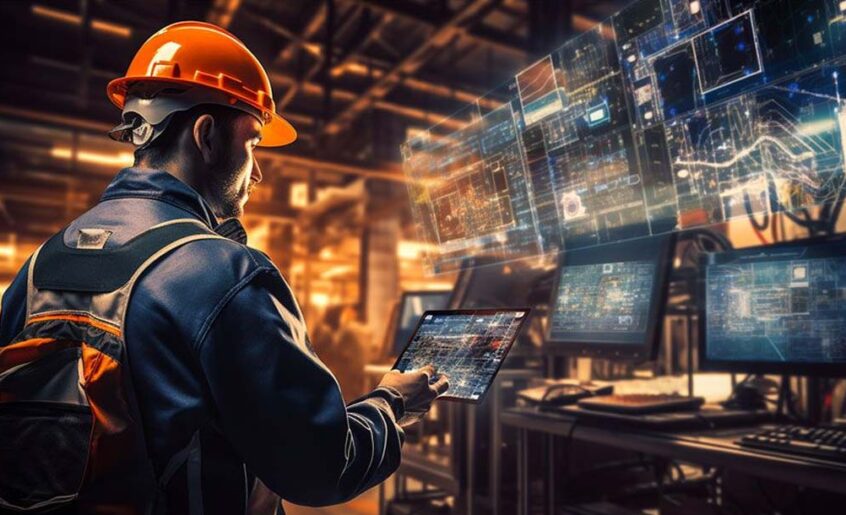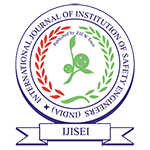The Future of Workplace Safety: Integrating AI and IoT in Occupational Health and Safety Programs

Volume 7, Issue 3, July- September 2024
The Future of Workplace Safety: Integrating AI and IoT in Occupational Health and Safety Programs
Aswad Manal
CEng (OHS), Level 7 IDip, MBA, PGDIS, B.Tech. Working as HSE Engineer in Project Delivery department, OQ Exploration and Production
Email id: aswadmanal11@gmail.com
Abstract
The integration of Artificial Intelligence (AI) and the Internet of Things (IoT) into Occupational Health and Safety (OHS) programs is transforming workplace safety across industries worldwide. These technologies enable proactive risk management and advanced safety compliance by monitoring, predicting, and even preventing incidents. This article explores the transformative role of AI and IoT in workplace safety, with examples from both international and Indian contexts, and highlights current trends and potential challenges.
1. Introduction
The integration of Artificial Intelligence (AI) and the Internet of Things (IoT) into Occupational Health and Safety (OHS) programs is transforming workplace safety across industries worldwide. These technologies enable proactive risk management and advanced safety compliance by monitoring, predicting, and even preventing incidents. This article explores the transformative role of AI and IoT in workplace safety, with examples from both international and Indian contexts, and highlights current trends and potential challenges.
2. Understanding AI and IoT in the OHS Context
- AI in OHS: AI leverages machine learning, computer vision, and natural language processing to analyze vast amounts of workplace data. This helps identify hazards, predict accidents, and recommend safety improvements. For example, machine learning algorithms can analyze historical data to identify recurring accident patterns, thereby allowing companies to mitigate risks proactively.
- IoT in OHS: IoT devices, such as sensors and wearables, collect real-time data on environmental conditions and employee health metrics, including air quality, temperature, noise levels, and vital signs.
This data provides ongoing insights into workplace safety, creating a responsive and adaptive safety environment.
3. Key Benefits of AI and IoT in Workplace Safety
- Proactive Hazard Detection: AI algorithms analyze both historical and real-time data to identify hazards before they result in accidents. A recent study indicates that machine learning algorithms can significantly reduce workplace incidents by detecting patterns indicative of potential hazards.
- Real-Time Monitoring and Alerts: IoT devices, including gas sensors and temperature monitors, are crucial in high-risk industries such as construction, mining, and manufacturing. These devices continuously monitor environmental conditions and send alerts when safety thresholds are breached, allowing employees to evacuate or take protective action.
- Wearable Technology: Wearables like smart helmets and wristbands track vital signs and fatigue levels, alerting both workers and supervisors when data indicates a need for rest or hydration. This approach has proven effective in preventing incidents due to exhaustion and heat stress.
4. Real-Life Examples of AI and IoT in Action
Global Examples:
- Amazon’s AI-Driven Safety in Warehouses: Amazon employs AI and robotics in its warehouses to enhance worker safety. During the COVID-19 pandemic, Amazon developed “Distance Assistant,” a computer vision tool that monitors and alerts workers if they are not maintaining safe distances. This tool is part of a broader AI-driven safety initiative that monitors workplace conditions to prevent accidents.
- Construction Site Safety with IoT and Wearables at Skanska: Construction giant Skanska uses IoT-enabled wearables to monitor worker movements, locations, and equipment usage in real time. This monitoring system has led to a significant reduction in incidents, with real-time data analysis revealing high-risk activities and unsafe work areas. The technology used includes SmartCap for fatigue monitoring and Spot-r for tracking worker location.
- BP’s Use of Predictive Maintenance in Oil and Gas: BP employs AI-powered predictive maintenance in its operations, using IoT sensors to monitor equipment for early signs of malfunction. This proactive approach has minimized equipment-related incidents, improved worker safety, and reduced costly downtime. For example, BP’s systems use AI to monitor corrosion, cutting manual inspections by 70%.
- CIM Emergency Preparedness and Crisis Management Solution: The Critical Incident Management (CIM) Solution leverages AI and IoT to provide real-time data during emergencies, including evacuation plans and resource allocation. It has improved response times and minimized safety lapses during crises in industries like oil and gas.
- Incident Investigation Tools Like Tap Root: TapRoot, an incident investigation system, simplifies the root cause analysis of workplace accidents. By identifying systemic issues, TapRoot enables organizations to implement effective preventive measures.
- Defensive Driving and Driver Fatigue Management System (DFMS): OPAL’s guidelines mandate installing fatigue detection systems integrated with In-Vehicle Monitoring Systems (IVMS) in fleet vehicles. These systems, like SmartDrive, actively monitor driver alertness and issue warnings to prevent accidents.
5. Indian Examples:
- Tata Steel’s Digital Twin for Predictive Safety: Tata Steel, a leading steel manufacturer in India, has introduced a Digital Twin system that uses IoT-enabled sensors and AI to monitor machinery and predict potential issues before they cause accidents. The system also uses computer vision to check for PPE compliance among workers, reinforcing safety protocols on the factory floor.
- JSW Steel’s IoT-Enabled Worker Safety Program: At JSW Steel, IoT devices monitor air quality, noise, and temperature in real time. Employees wear smart devices that alert them to dangerous environmental conditions, allowing for immediate corrective action. This has led to significant improvements in employee health and safety.
- Indian Railways’ IoT-Driven Predictive Safety Initiatives: Indian Railways uses IoT sensors on its tracks and trains to monitor for anomalies. For example, the Railway Track Management System integrates IoT and AI to predict and address track weaknesses, reducing maintenance-related hazards.
6. Addressing Occupational Health Beyond Safety
- Preventing Repetitive Stress Injuries: Wearables can monitor workers’ repetitive movements, common in sectors like automotive manufacturing, where repetitive tasks often lead to injuries. In India, Maruti Suzuki has implemented IoT devices to track repetitive motions, reducing musculoskeletal strain by redesigning workstations and schedules.
- Mental Health Monitoring: IoT devices and AI systems can help detect signs of emotional fatigue or stress, using metrics like heart rate variability. Companies can leverage this data to promote healthier work routines, reducing mental health-related absenteeism and enhancing overall productivity. The Driver Fatigue Management System (DFMS) specifically addresses this by monitoring fatigue levels among drivers to prevent road accidents.
7. Challenges to Implementation
- Privacy Concerns: Real-time tracking through wearable technology raises privacy issues, particularly regarding sensitive health data. Companies need to ensure they comply with data protection regulations, such as India’s Personal Data Protection Bill (2022).
- High Costs: For small and medium enterprises, the cost of implementing AI and IoT-based safety solutions can be prohibitive. Although costs are decreasing, widespread adoption remains limited due to budget constraints.
- Data Security: IoT devices often collect sensitive data that must be protected. Cybersecurity is crucial to safeguard both privacy and physical safety, as a data breach could compromise device functionality, endangering workers.
8. Future Trends in AI and IoT for OHS
- Advanced Predictive Analytics: With access to larger datasets, AI-powered predictive systems will provide even more accurate predictions, allowing companies to take preventative actions earlier.
- Augmented Reality (AR) Training Programs: AR is expected to revolutionize safety training, especially in high-risk environments. Workers can undergo immersive training that simulates real workplace hazards, preparing them for emergency situations.
- 5G and Edge Computing: With the rollout of 5G in India, IoT applications are becoming more efficient. For instance, enhanced bandwidth and reduced latency improve real-time monitoring and decision-making in hazardous environments.
9. Conclusion
AI and IoT are playing a transformative role in occupational health and safety worldwide, including in India’s fast-evolving industrial landscape. By proactively addressing risks and implementing real-time monitoring, companies are not only improving safety but also fostering a culture of well-being and responsibility. As these technologies continue to advance, the future of workplace safety will be marked by predictive capabilities, immersive training, and human-centred design, moving beyond compliance to genuinely protect and empower the workforce.
10. References
- Amazon (2020). Amazon develops “Distance Assistant” to help protect workers.
- BP (2020). Using AI for Predictive Maintenance to Enhance Safety in Oil & Gas Operations.
- Indian Railways (2022). Indian Railways integrates IoT and AI for predictive safety. The Economic Times. Available at: https://economictimes.indiatimes.com.
- Global FMS Tech. (GFMS) https://fms-tech.com.
- JSW Steel (2020). IoT technology in safety: Real-time tracking in steel manufacturing. JSW Steel Press Release.
- Maruti Suzuki (2021). Occupational safety innovations in Indian automotive industry. Maruti Suzuki Press Release.
- Oman Society for Petroleum Services (OPAL), 2024. OPAL Road Safety Standard V 4.0.
- Skanska (2021). IoT-Enabled Wearables Transform Safety on Construction Sites. Skanska USA Press Release. Available at: https://www.usa.skanska.com.
- Tata Steel (2021). Tata Steel leverages AI and IoT for enhanced workplace safety. Tata Steel Press Release.
